Formation of Calcium Oxalate Patinas as Protective Layer on Basaltic Stone Surfaces of 17th Century Raigad Hill Fort, India
Abstract
:1. Introduction
Raigad Hill Fort, Its Structure and Environment
2. Materials and Methods
3. Results
3.1. Optical Analysis
3.2. Mineralogical Analysis
3.3. Morphological Analysis
4. Discussion
5. Conclusions
Author Contributions
Funding
Data Availability Statement
Acknowledgments
Conflicts of Interest
References
- Jones, D.; Wilson, M.J.; Tait, J.M. Weathering of a basalt by Pertusaria corallina. Lichenologist 1980, 12, 277–290. [Google Scholar] [CrossRef]
- Arocena, J.M.; Siddique, T.; Thring, R.W.; Kapur, S. Investigation of lichens using molecular techniques and associated mineral accumulations on a basaltic flow in a Mediterranean environment. Catena 2007, 70, 356–365. [Google Scholar] [CrossRef]
- Columbu, S.; Piras, G.; Sitzia, F.; Pagnotta, S.; Raneri, S.; Legnaioli, S.; Palleschi, V.; Lezzerini, M.; Giamello, M. Petrographic and mineralogical characterization of volcanic rocks and surface-depositions on romanesque monuments. Mediterr. Archaeol. Archaeom. 2018, 18, 37–64. [Google Scholar] [CrossRef]
- Liebig, J. XI.—Note on thierschite. Q. J. Chem. Soc. Lond. 1854, 6, 112–113. [Google Scholar] [CrossRef] [Green Version]
- Cipriani, C.; Franchi, L. The presence of whewellite in alteration crust of Roman monuments. Boll. Serv. Geol. Ital. 1958, 79, 555–556. [Google Scholar]
- Arocena, J.M.; Zhu, L.P.; Hall, K. Mineral accumulations induced by biological activity on granitic rocks in Qinghai Plateau, China. Earth Surf. Process. Landf. J. Br. Geomorphol. Res. Group 2003, 28, 1429–1437. [Google Scholar] [CrossRef]
- Bonazza, A.; Messina, P.; Sabbioni, C.; Grossi, C.M.; Brimblecombe, P. Mapping the impact of climate change on surface recession of carbonate buildings in Europe. Sci. Total Environ. 2009, 407, 2039–2050. [Google Scholar] [CrossRef]
- Del Monte, M.; Sabbioni, C. Weddellite on limestone in the Venice [Italy] environment. Environ. Sci. Technol. 1983, 17, 518–522. [Google Scholar] [CrossRef]
- Gómez-Bolea, A.; Llop, E.; Ariño, X.; Saiz-Jimenez, C.; Bonazza, A.; Messina, P.; Sabbioni, C. Mapping the impact of climate change on biomass accumulation on stone. J. Cult. Herit. 2012, 13, 254–258. [Google Scholar] [CrossRef]
- Kanth, A.P.; Singh, M.R. Vibrational spectroscopy and SEM-EDX analysis of wall painted surfaces, Orchha Fort, India. J. Archaeol. Sci. Rep. 2019, 24, 434–444. [Google Scholar] [CrossRef]
- Carmona, N.; Villegas, M.A.; Navarro, J.F. Characterisation of an intermediate decay phenomenon of historical glasses. J. Mater. Sci. 2006, 41, 2339–2346. [Google Scholar] [CrossRef]
- Bonazza, A.; Natali, C.; Ghedini, N.; Vaccaro, C.; Sabbioni, C. Oxalate patinas on stone monuments in the Venetian Lagoon: Characterization and origin. Int. J. Archit. Herit. 2015, 9, 542–552. [Google Scholar] [CrossRef]
- El-Derby, A.A.O.D.; Mansour, M.M.A.; Salem, M.Z.M. Investigation the microbial deterioration of sandstone from the osirion’s sarcophagus chamber as affected by rising ground water level. Mediterr. Archaeol. Archaeom. 2016, 16, 273–281. [Google Scholar] [CrossRef]
- Alessandrini, G.; Amicarelli, V.; Bellini, A.; Biscontin, G.; Cecchi, R.; Fassina, V. The Oxalate Films: Origin and Significance in the Conservation of Works of Art; Centro Congressi Cariplo: Milan, Italy, 1989. [Google Scholar]
- Manganelli, C.; Del, F.; Camaiti, M.; Borselli, G.; Maravalaki, P.; Taino, P. The Oxalate Films: Origin and Significance in the Conservation of Works of Art; Centro Congressi Cariplo: Milan, Italy, 1989. [Google Scholar]
- Cariati, F.; Rampazzi, L.; Toniolo, L.; Pozzi, A. Calcium oxalate films on stone surfaces: Experimental assessment of the chemical formation. Stud. Conserv. 2000, 45, 180–188. [Google Scholar]
- Aulinas, M.; Garcia-Valles, M.; Gimeno, D.; Fernandez-Turiel, J.L.; Ruggieri, F.; Pugès, M. Weathering patinas on the medieval (S. XIV) stained glass windows of the Pedralbes Monastery (Barcelona, Spain). Environ. Sci. Pollut. Res. 2009, 16, 443–452. [Google Scholar] [CrossRef]
- Conti, C.; Brambilla, L.; Colombo, C.; Dellasega, D.; Gatta, G.D.; Realini, M.; Zerbi, G. Stability and transformation mechanism of weddellite nanocrystals studied by X-ray diffraction and infrared spectroscopy. Phys. Chem. Chem. Phys. 2010, 12, 14560–14566. [Google Scholar] [CrossRef]
- Conti, C.; Casati, M.; Colombo, C.; Realini, M.; Brambilla, L.; Zerbi, G. Phase transformation of calcium oxalate dihydrate–monohydrate: Effects of relative humidity and new spectroscopic data. Spectrochim. Acta Part A Mol. Biomol. Spectrosc. 2014, 128, 413–419. [Google Scholar] [CrossRef]
- Najafi, S.J.; Cox, K.G.; Sukheswala, R.N. Geology and geochemistry of the basalt flows (Deccan Traps) of the Mahad-Mahabaleshwar section, India. In Deccan Volcanism and Related Provinces in Other Parts of the World; Subbaro, K.V., Sukheswala, R.N., Eds.; Geological Society of India: Bangalore, India, 1981; Volume 3, pp. 300–315. [Google Scholar]
- Kothari, M.J.; Moorthy, S. Flora of Raigad District Maharashtra State; Flora of India Series 3; Botanical Survey of India: Calcutta, India, 1993. [Google Scholar]
- Fraser-Jenkins, C.R.; Gandhi, K.N.; Kholia, B.S.; Benniamin, A. An Annotated Checklist of Indian Pteridophytes; Bishen Singh Mahendra Pal Singh: Dehra Dun, India, 2017. [Google Scholar]
- Salama, K.K.; Ali, M.F.; El Sheikh, S.M. A comparison between nano calcium carbonate, natural calcium carbonate and converted calcium hydroxide for consolidation. Sci. Cult. 2019, 5, 35–40. [Google Scholar] [CrossRef]
- King, H.E.; Mattner, D.C.; Plümper, O.; Geisler, T.; Putnis, A. Forming cohesive calcium oxalate layers on marble surfaces for stone conservation. Cryst. Growth Des. 2014, 14, 3910–3917. [Google Scholar] [CrossRef]
- La Russa, M.F.; Ruffolo, S.A.; Barone, G.; Crisci, G.M.; Mazzoleni, P.; Pezzino, A. The use of FTIR and micro-FTIR spectroscopy: An example of application to cultural heritage. Int. J. Spectrosc. 2009, 2009, 893528. [Google Scholar] [CrossRef] [Green Version]
- Pavía, S.; Caro, S. Origin of films on monumental stone. Stud. Conserv. 2006, 51, 177–188. [Google Scholar]
- Horner, H.T.L.; Tiffany, H.; Cody, A.M. Calcium oxalate bipyramidal crystals on the basidiocarps of Geastrum minus (Lycoperdales). Proc. Iowa Acad. Sci. 1985, 92, 70–77. [Google Scholar]
- Gadd, G.M.; Bahri-Esfahani, J.; Li, Q.; Rhee, Y.J.; Wei, Z.; Fomina, M.; Liang, X. Oxalate production by fungi: Significance in geomycology, biodeterioration and bioremediation. Fungal Biol. Rev. 2014, 28, 36–55. [Google Scholar]
- Del Monte, M.; Sabbioni, C.; Zappia, G. The origin of calcium oxalates on historical buildings, monuments and natural outcrops. Sci. Total Environ. 1987, 67, 17–39. [Google Scholar]
- Fassina, V.; Molteni, C. Problemi di conservazione connessi all’umidita delle murature: La diagnostica e le tecnologie conservative applicate al restauro della cripta di S. Marco in Venezia. In Proceedings of the 3rd International Symposium on the Conservation of Monuments in the Mediterranean Basin, Venice, Italy, 22–25 June 1994; pp. 803–813. [Google Scholar]
- Kawamura, K.; Kaplan, I.R. Motor exhaust emissions as a primary source for dicarboxylic acids in Los Angeles ambient air. Environ. Sci. Technol. 1987, 21, 105–110. [Google Scholar] [CrossRef]
- Martinelango, P.K.; Dasgupta, P.K.; Al-Horr, R.S. Atmospheric production of oxalic acid/oxalate and nitric acid/nitrate in the Tampa Bay airshed: Parallel pathways. Atmos. Environ. 2007, 41, 4258–4269. [Google Scholar] [CrossRef]
- Saiz-Jimenez, C. Biogenic vs. anthropogenic oxalic acid in the environment. In Le Pellicole ad Ossalati: Origine e Significato Nella Conservazione delle Opere d’Arte; Centro CNR “Gino Bozza”: Milano, Italy, 1989; pp. 207–214. [Google Scholar]
- Ciccarone, C.; Pinna, D. Calcium oxalate films on stone monuments—Microbiological investigations. Aerobiologia 1993, 9, 33–37. [Google Scholar] [CrossRef]
- Del Monte, M.; Sabbioni, C. A study of the patina called ‘scialbatura’ on imperial Roman marbles. Stud. Conserv. 1987, 32, 114–121. [Google Scholar] [CrossRef]
- Hernanz, A.; Gavira-Vallejo, J.M.; Ruiz-López, J.F. Calcium oxalates and prehistoric paintings. The usefulness of these biomaterials. J. Optoelectron. Adv. Mater. 2007, 9, 512–521. [Google Scholar]
- Karche, T.; Singh, M.R. Biologically induced calcium oxalate mineralization on 15th century lime mortar, Murud Sea fort, India. J. Archaeol. Sci. Rep. 2021, 39, 103178. [Google Scholar] [CrossRef]
- Singh, M.R.; Ganaraj, K.; Sable, P.D. Surface mediated Ca-phosphate biomineralization and characterization of the historic lime mortar, Janjira Sea Fort, India. J. Cult. Herit. 2020, 44, 110–119. [Google Scholar] [CrossRef]
- Singh, M.R.; Vinodh, K.S.; Ganaraj, K. Evidence of amorphous Ca-phosphate precipitate caused by bio mineralisation in 4–5th CE lime plasters of the previously submerged east coastal monument of Salvankuppam. Mineralogia 2022, 52, 19–30. [Google Scholar] [CrossRef]
- Ariño, X.; Ortega-Calvo, J.J.; Gomez-Bolea, A.; Saiz-Jimenez, C. Lichen colonization of the Roman pavement at Baelo Claudia (Cadiz, Spain): Biodeterioration vs. bioprotection. Sci. Total Environ. 1995, 167, 353–363. [Google Scholar] [CrossRef] [Green Version]
- Adamo, P.; Violante, P. Weathering of rocks and neogenesis of minerals associated with lichen activity. Appl. Clay Sci. 2000, 16, 229–256. [Google Scholar] [CrossRef]
- Kanth, A.P.; Singh, M.R. Spectroscopic and chromatographic investigation of the wall painted surfaces of an 18th century Indian temple, New Delhi. Vib. Spectrosc. 2019, 104, 102947. [Google Scholar] [CrossRef]
- Chen, J.; Blume, H.P.; Beyer, L. Weathering of rocks induced by lichen colonization—A review. Catena 2000, 39, 121–146. [Google Scholar] [CrossRef]
- Edwards, H.G.M.; Farwell, D.W.; Seaward, M.R.D.; Giacobini, C. Preliminary Raman microscopic analyses of a lichen encrustation involved in the biodeterioration of Renaissance frescoes in central Italy. Int. Biodeterior. 1991, 27, 1–9. [Google Scholar] [CrossRef]
- Krumbein, W.E.; Ciabach, J. Biology of stone and minerals in buildings—Biodeterioration, biotransfer, bioprotection. In Proceedings of the VIth International Congress on Deterioration and Conservation of Stone, Torun, Poland, 12–14 September 1988; Nicholas Copernicus University: Torun, Poland, 1988; pp. 1–12. [Google Scholar]
- Krumbein, W.E.; Petersen, K.; Schellnhuber, H.J. On the geomicrobiology of yellow, orange, red, brown and black films and crusts developing on several different types of stone and objects of art. In Le Pellicole ad Ossalati: Origine e Significato Nella Conservazione Delle Opere d’Arte; Centro CNR “Gino Bozza”: Milano, Italy, 1989; pp. 337–348. [Google Scholar]
- Anagnostidis, K.; Gehrmann, C.K.; Gross, M.; Krumbein, W.E.; Lisi, S.; Pantazidou, A.; Urzì, C.; Zagari, M. Biodeterioration of marbles of the Parthenon and Propylaea, Acropolis, Athens-associated organisms, decay and treatment suggestions. In La Conservation des Monuments Dans le Bassin Méditerranéen: Actes du 2ème Symposium International; Musée d’Art et d’Histoire: Geneva, Switzerland, 1991; pp. 305–325. [Google Scholar]
- Warscheid, T.; Petersen, K.; Krumbein, W.E.; Ciabach, J. Physiological characterization of chemoorganotrophic bacteria isolated from sandstones. In Proceedings of the VIth International Congress on Deterioration and Conservation of Stone, Torun, Poland, 12–14 September 1988; Nicholas Copernicus University: Torun, Poland, 1988; pp. 26–32. [Google Scholar]
- Palmer, R.J., Jr.; Hirsch, P. Photosynthesis-based microbial communities on two churches in northern Germany: Weathering of granite and glazed brick. Geomicrobiol. J. 1991, 9, 103–118. [Google Scholar] [CrossRef]
- Alessandrini, G.; Bonecchi, R.; Peruzzi, R.; Toniolo, L. Caratteristiche composizionali e morfologiche di pellicole ad ossalato: Studio comparato su substrati lapidei di diversa natura. In Le Pellicole ad Ossalati: Origine e Significato Nella Conservazione delle Opere d’Arte; Centro CNR “Gino Bozza”: Milano, Italy, 1989; pp. 137–150. [Google Scholar]
- Adamo, P.; Colombo, C.; Violante, P. Iron oxides and hydroxides in the weathering interface between Stereocaulon vesuvianum and volcanic rock. Clay Miner. 1997, 32, 453–461. [Google Scholar] [CrossRef]
- Abeer, F. Elhagrassy and Amira Hakeem Comparative study of biological cleaning and laser techniques for conservation of weathered stone in Failaka Island, Kuwait. Sci. Cult. 2018, 4, 43–50. [Google Scholar] [CrossRef]
- Monte, M. Biogenesis of oxalate patinas on marble specimens in fungal culture. Aerobiologia 2003, 19, 271–275. [Google Scholar] [CrossRef]
- Franzini, M.; Gratziu, C.; Wicks, E. Calcium oxalate films on marble monuments. Rend. Soc. Ital. Mineral. Petrol. 1984, 39, 59–70. [Google Scholar]
- Lazzarini, L.; Salvadori, O. A reassessment of the formation of the patina called scialbatura. Stud. Conserv. 1989, 34, 20–26. [Google Scholar] [CrossRef]
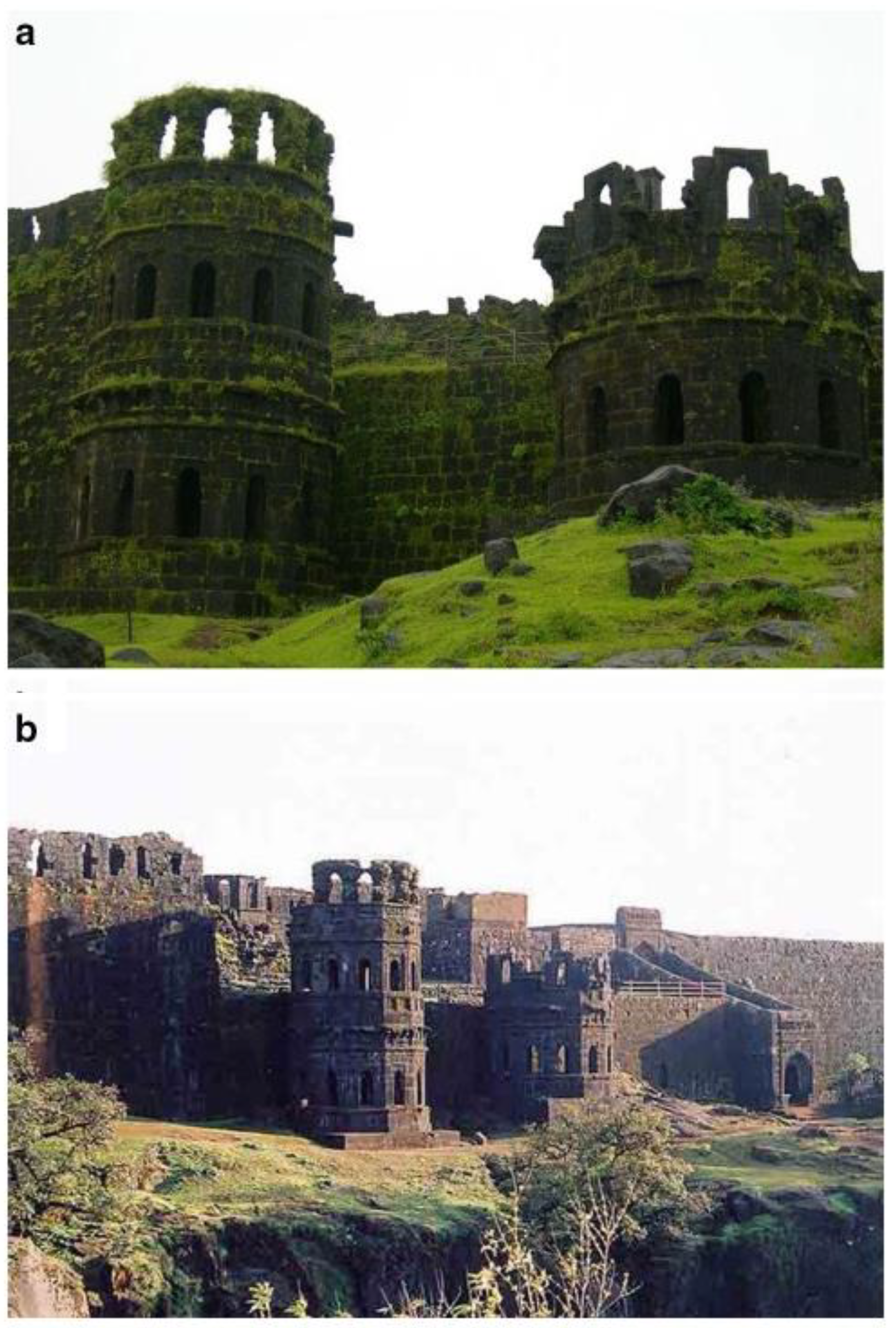
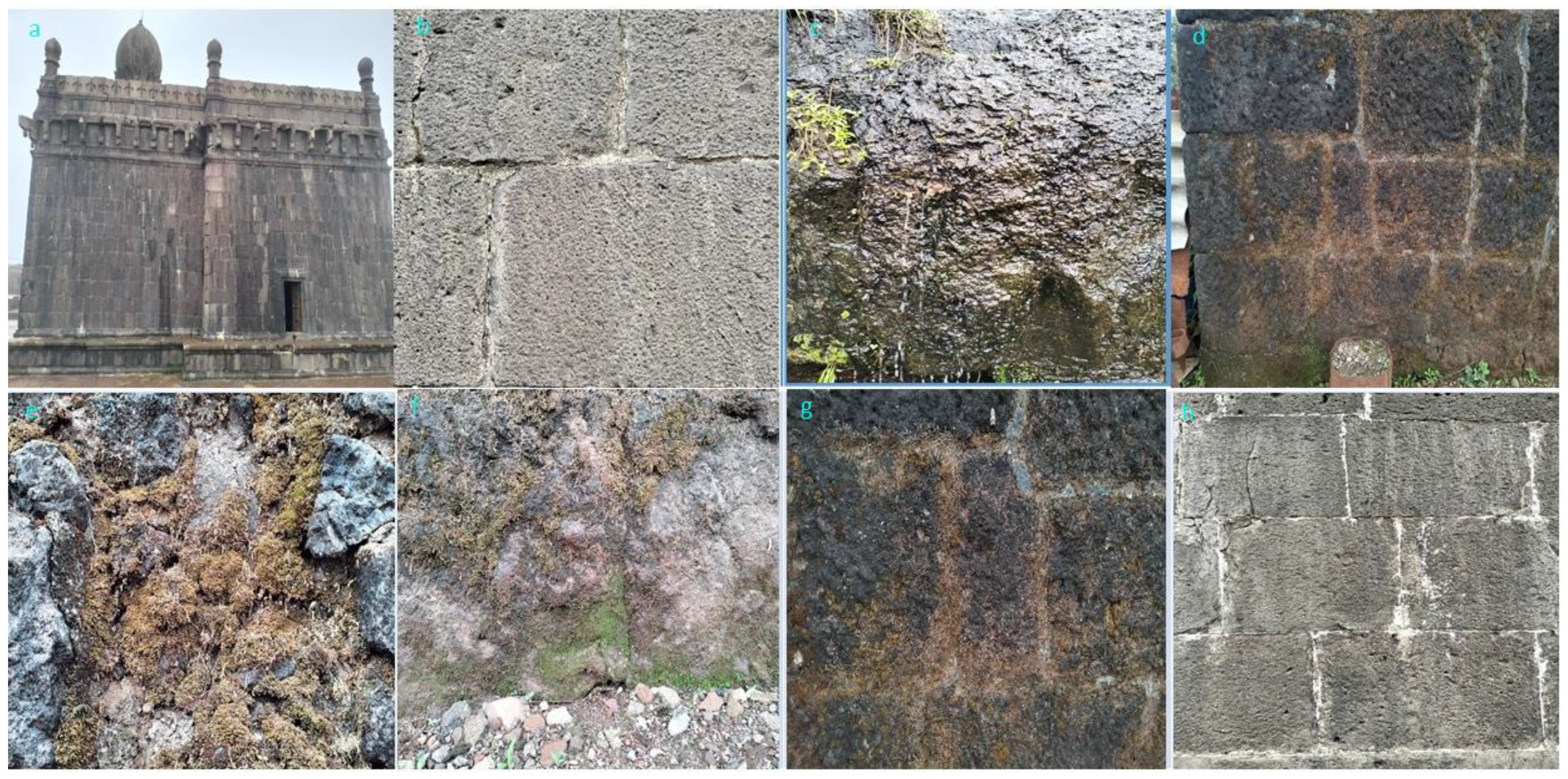


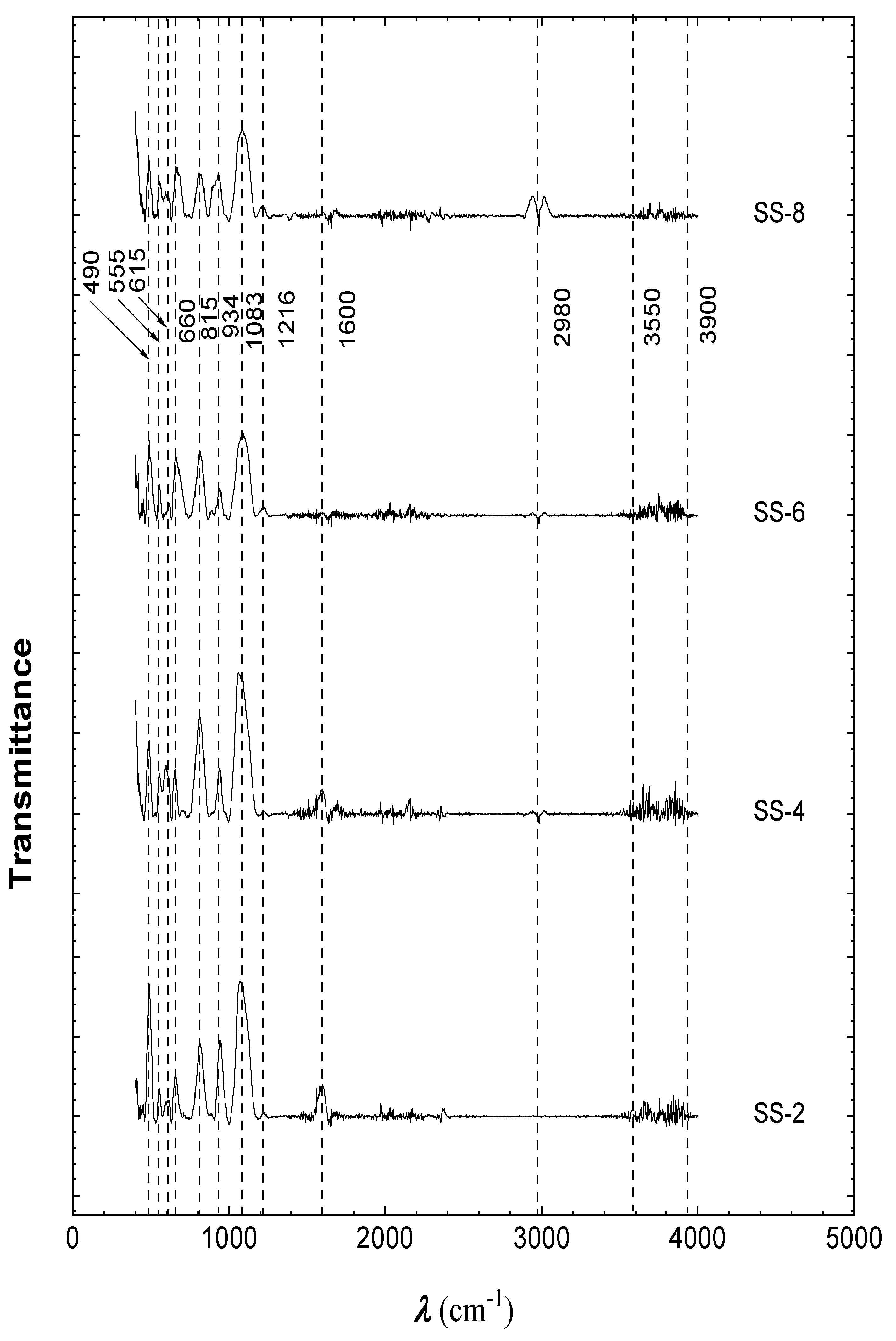

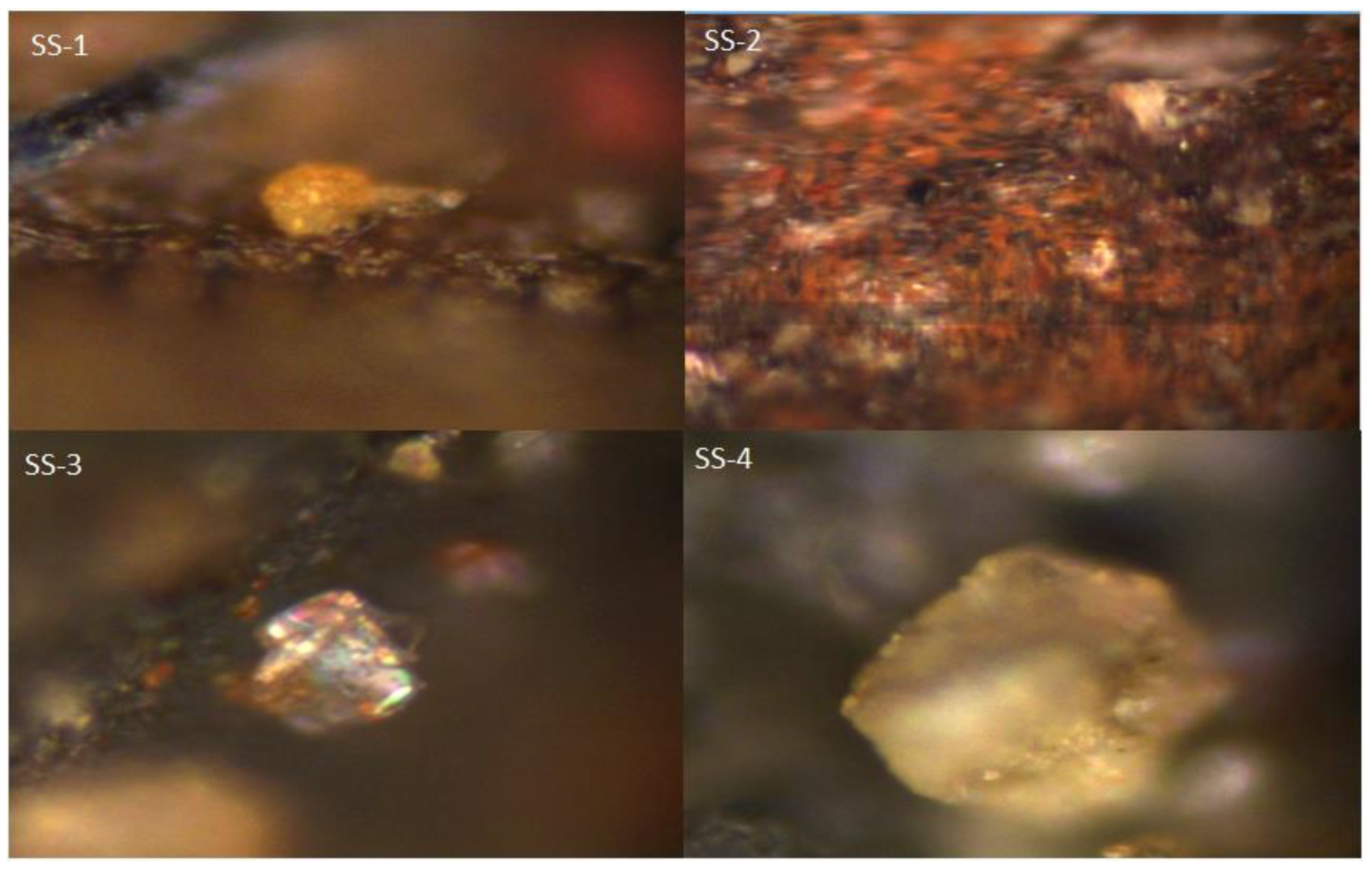

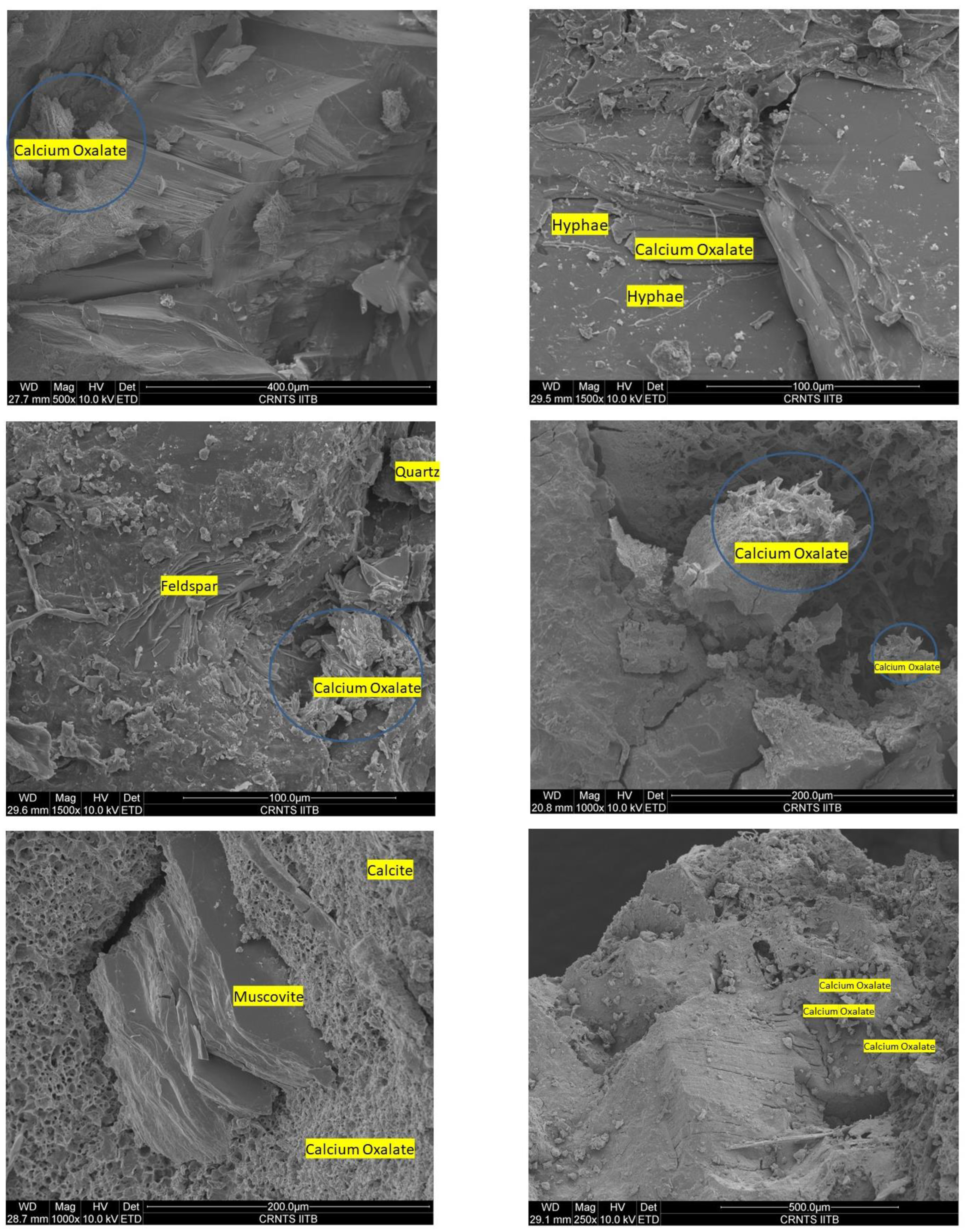
| Major Components | Weight Percentage |
|---|---|
| SiO2 | 45–52% |
| K2O and Na2O | 2–5% |
| TiO2 | 0.5–2% |
| Fe2O3 | 5–14% |
| Al2O3 | about 14% |
| MgO | 5–12% |
| CaO | 10–12% |
| Designation | Sample | Additional Details | Location |
|---|---|---|---|
| SS-1 | Stone sample | East Facing Wall (Stone) | Haathi Khana |
| SS-2 | Stone sample | West Facing Wall | Back Side of Bazaar Peth |
| SS-3 | Stone sample | East Facing wall near Samadhi (Stone) | Jagdishwar Temple |
| SS-4 | Stone sample | Peth Structure-11 (Right) | Inside of Bazaar |
| SS-5 | Stone sample | North Facing Wall | Near Nagar Khana |
| SS-6 | Stone sample | South Facing Wall | Outer Wall of Nagar Khana |
| SS-7 | Stone sample | East Facing Wall | Outer wall of Nagar Khana |
| SS-8 | Stone sample | Burning Patch from Back Plinth | Inside of Simhasan |
| SS-9 | Stone sample | East Facing | Outer Wall of Queen Palace |
| Sample | Frequency (cm−1) | Mineral | Assignment |
|---|---|---|---|
| Stone Samples | 490 | Muscovite | Al-O Bending Vibration |
| 555 | Orthoclase | Si-O Stretch | |
| 615 | Orthoclase | Al-O Coordination Vibration | |
| 660 | Water molecule | Wagging of Water Molecule | |
| 815 | Orthoclase, Muscovite | Si-O stretch, Si-O-Al Stretch, | |
| 935 | Calcium Oxalate | C=C Stretching | |
| 1080 | Orthoclase, Muscovite | Si-O-Si Stretch | |
| 1215 | Calcium Oxalate | C-C(=O)-O Stretching | |
| 1620 | Calcium Oxalate | OC=O Asymmetrical Stretching | |
| 1650 | Calcium Oxalate | Stretching | |
| 2330 | Calcium Oxalate | O=C=O Stretching | |
| 3000 | Aliphatic Group | Asymmetric C-H Group | |
| 3600–3900 | Calcium Oxalate Monohydrate | O-H Stretching |
| Sample Designation/Elements | SS-1 | SS-3 | SS-4 | SS-6 | SS-7 |
|---|---|---|---|---|---|
| C | 15.6 | 14.5 | 14.0 | 45.3 | 32.8 |
| N | 3.4 | 2.8 | 1.7 | 1.6 | 4.3 |
| O | 43.8 | 45.8 | 46.9 | 40.3 | 44.4 |
| F | 2.1 | 0.5 | 0.7 | 0.0 | 0.3 |
| Na | 0.8 | 0.1 | 0.7 | 0.0 | 0.1 |
| Mg | 1.4 | 1.3 | 2.7 | 0.3 | 1.3 |
| Al | 4.6 | 4.5 | 4.1 | 1.8 | 0.0 |
| Si | 12.4 | 14.5 | 14.5 | 4.4 | 8.4 |
| P | 4.4 | 5.8 | 2.6 | 1.4 | 2.2 |
| S | 0.2 | 0.2 | 0.1 | 0.1 | 0.1 |
| Cl | 0.1 | 0.1 | 0.0 | 0.0 | 0.0 |
| K | 0.6 | 0.5 | 0.4 | 0.1 | 0.0 |
| Ca | 3.6 | 3.4 | 3.4 | 2.0 | 2.1 |
| Fe | 7.1 | 5.9 | 7.8 | 2.7 | 4.0 |
Disclaimer/Publisher’s Note: The statements, opinions and data contained in all publications are solely those of the individual author(s) and contributor(s) and not of MDPI and/or the editor(s). MDPI and/or the editor(s) disclaim responsibility for any injury to people or property resulting from any ideas, methods, instructions or products referred to in the content. |
© 2023 by the authors. Licensee MDPI, Basel, Switzerland. This article is an open access article distributed under the terms and conditions of the Creative Commons Attribution (CC BY) license (https://creativecommons.org/licenses/by/4.0/).
Share and Cite
Singh, M.R.; Yadav, R. Formation of Calcium Oxalate Patinas as Protective Layer on Basaltic Stone Surfaces of 17th Century Raigad Hill Fort, India. Heritage 2023, 6, 5374-5392. https://doi.org/10.3390/heritage6070283
Singh MR, Yadav R. Formation of Calcium Oxalate Patinas as Protective Layer on Basaltic Stone Surfaces of 17th Century Raigad Hill Fort, India. Heritage. 2023; 6(7):5374-5392. https://doi.org/10.3390/heritage6070283
Chicago/Turabian StyleSingh, Manager Rajdeo, and Rajendra Yadav. 2023. "Formation of Calcium Oxalate Patinas as Protective Layer on Basaltic Stone Surfaces of 17th Century Raigad Hill Fort, India" Heritage 6, no. 7: 5374-5392. https://doi.org/10.3390/heritage6070283






